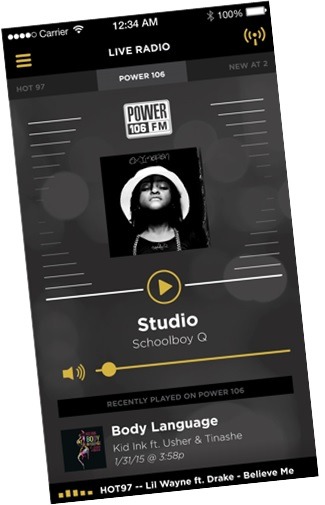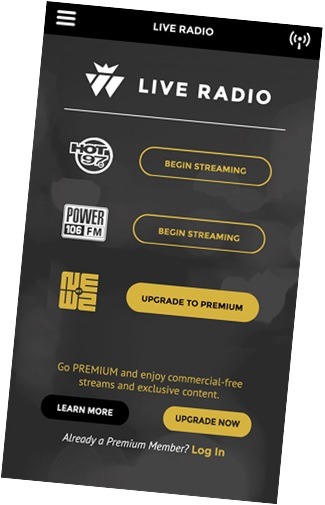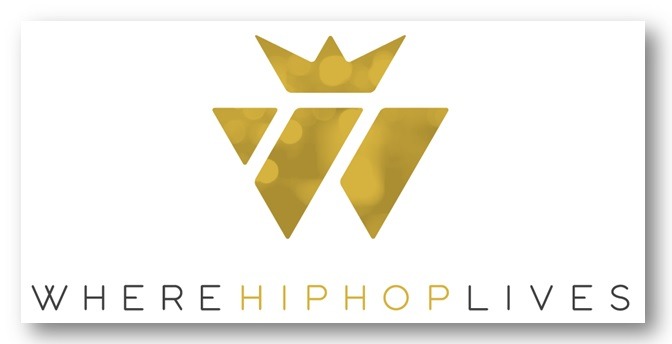With mega-brands like Hot 97 in New York and Power 106 in Los Angeles, Emmis Communications has been and continues to be the radio industry leader for major market Hip-Hop exposure on both coasts with music, larger-than-life talent, major events, and a commitment to embodying all-things Hip-Hop.
In this space, we talk a great deal about leveraging and extending great radio brands in novel and innovative ways. In that spirit, Emmis began looking at ways to take those two iconic brands and make them bigger; from the two largest markets in the U.S. to becoming the national, and even, the international home of Hip-Hop.
In that spirit, Emmis designed and launched “Where Hip-Hop Lives,” a mobile app that takes the best of both stations, adds more robust content, and makes the whole package available to people across the country and, as of late August, the entire world.
To learn more about this ambitious project, we spoke to Trinity Brocato who may have the best title in the radio industry: National Director of Mobile Innovation. Tasked with growing the “Where Hip-Hop Lives” app, she discussed the initiative’s goals, challenges and other issues in this week’s edition of Radio’s Most Innovative.
JM: Let’s start by talking about Hip-Hop as a genre. How strong is it today?
TB: Hip-Hop is probably bigger than it’s ever been and now offers something for almost anyone. Your Hip-Hop fan is no longer someone you can just put in a box. There are all of these little nuances that make up what is now Hip-Hop music. So as content providers, we have to deliver a broad spectrum and try to open up the discussion around Hip-Hop to try to super serve more than one kind of fan. And that’s a really big part of the reason we introduced “Where Hip-Hop Lives.” So that whether you are in New York, Atlanta or London, if you like this music, we’re going to do what we can to serve it to you.
 JM: Do you see mobile technology as being more prevalent among Hip-Hop listeners than other genres?
JM: Do you see mobile technology as being more prevalent among Hip-Hop listeners than other genres?
TB: Yes, absolutely. The urban culture is the first to adopt new technology. They are absolutely “the new every two” with the latest and greatest. So if we wanted to reach our core audience, we needed to do so on the toys they’re already carrying around. The reality is if you put up a transmitter and launched a new station tomorrow, you’re going to have a hard time getting this audience because they’re not going to know that you exist. You have to be where they are, and they are on mobile.
JM: How did the idea for this app come about?
TB: Our digital analytics showed us these two brands were not local; they were national and worldwide. A large percentage of our streaming audience was out of market and our digital content was being consumed across the US.
Our challenge was to combine the power of these two beacons and really spread the footprint even farther. The answer was to stop treating them as separate entities, and put their power together under an umbrella called “Where Hip-Hop Lives” that gives everyone access.
JM: Because of those two stations the app has a bi-coastal nature. How does that impact the project?
TB: I think it’s really additive. Instead of New York waiting to be introduced to an artist that hit in Los Angeles, now there is one home. So if you are interested in dabbling in the LA sound while you’re living in New York or vice versa, or you just want a mixture of new music from all over, you can jump into “New at 2,” our new music channel. Now there is one home for the music so you don’t have to scan the dial or search through Sound Cloud or YouTube. We’ve taken the guesswork, and the hunt and peck out of it, and instead are giving fans the best of the best in one location.
 JM: Does the content go beyond music?
JM: Does the content go beyond music?
TB: Sure. Obviously music is at the core, but it’s just one facet of the total culture. You’re not just Hip-Hop when you’re listening to the radio, you’re Hip-Hop in everything that you do – your movie interests, your clothing, everything.
We’ve done pieces on how Hip-Hop influences art, like the story of this young woman in LA who doesn’t look like a Hip-Hop fan but creates these fantastic oil paintings by listening to the music and painting what she feels.
And we’ve got Funk Flex (pictured right) who is always on the cutting edge of what’s happening. He has been key in showing us that our content should not just be about music. Flex has a systematic way of covering news, sports, and pop culture in addition to his new music bombs, and passion for sneakers and cars.
Just using shoes as an example, Flex always has the latest kicks and people want to see them, want to know where they can get them, want to, you know, drool on his collection. What we do is get that content through the application to them as fast as possible so they have it on the go.
JM: Besides Funk Flex’ great kicks, where does all that content come from?
TB: It’s primarily being curated from Hot and Power, so you’ve got LA and NYC represented. And we have contributors and bloggers, people who are cultural influencers. We partner with people who are representatives of the music and culture.
We also have an army of mixers. These guys don’t just come in and work a few hours and then go home. They are out hustling in the clubs, they are spinning every night. They are there. They get music on a blank CD or a jump drive that someone just cut, in some cases before the label even sees it.
JM: Of all the content on the app, has anything stood out as being the most popular?
TB: It’s absolutely access to brand new music. We broke the Meek Mill track when he finally released it, and we saw a huge spike. In fact, there was controversy and conversation that week on when it was going to drop, so it ultimately became a sort of water cooler moment. Meek’s camp passed that track to Funk Flex. He did the world premiere and we got it on the air as soon as possible. We got the message out through social, and it was fun to watch that sort of bubble up as quickly as it did.
JM: When you say got it on the air, do you mean the radio, the app, or both?
TB: It went simultaneously. So not only were we delivering it to New York through Hot 97, we delivered it across the nation through “Where Hip-Hop Lives.”
 JM: That really is the power you’ve got with the app. Has it led to the music industry getting involved?
JM: That really is the power you’ve got with the app. Has it led to the music industry getting involved?
TB: The bigger labels haven’t gotten involved yet. As with any large enterprise, you’ve got to go through the communication channels to even find the right person to deliver that information. But we have seen it with smaller artists. We did an exclusive with Omi around a live performance of “Cheerleader” that he did with Hot 97. The label was very much behind it, and we pushed it out as an exclusive within the app and saw a great response.
JM: I’m sure there have been challenges along the way. What is the biggest hurdle you’ve faced so far and how have you overcome it?
TB: The biggest hurdle was the brand new station. We have three live radio stations in the app, Hot 97, Power 106, and a brand new station called “New at 2” that showcases new music. They are all on the air 24/7 and require programming. Two of them have full staffs. As for the other one, I had six weeks to work with our excellent programming team and our crack engineering and IT teams to get it up and running. Definitely launching a 24/7/365 station in just under six weeks was the biggest challenge.
JM: Not all of the content on the app is free. What do listeners get with a premium subscription?
TB: One of the biggest offerings of our subscription package is the opportunity to listen to Hot and Power commercial free. We know this is very much an on-demand culture. We rarely sit and watch TV through commercials, we want to fast forward. We give you music instead of commercials during those breaks so you don’t have to sit through all the things that sort of break the vibe if you will. We give you wall to wall music. You can turn it on and let it play as though you were listening to your iPod but instead of only hearing music, you are aware of we’re going to continue to introduce you to new music.
Also the “New at 2” channel, which is part of the premium package, is all unedited; so it’s music you can’t hear on the radio. And we’ve got a couple of other things in the works that we’ll add to the subscription offering down the line. But you know, crawl, walk, run.
JM: How about sales? Have you started down that path of monetizing this effort through advertising?
TB: Emmis is always about super-serve your audience first. We didn’t want to come out of the gate with a bunch of ads. That really wasn’t the purpose. This is about the content and the experience first. From a content curation and a product development standpoint, which is where I sit, that’s been amazing. To not have to worry about the ads and just really build a product from the content standpoint.
JM: You mentioned content curation and in the initial press release about the app (Emmis CEO) Jeff Smulyan referred to Hot 97 and Power 106 as curators of the Hip-Hop lifestyle. How does the app enhance that role?
TB: It starts with the content coming out of LA and NY. We weed out that which is only germane to those cities like a morning show contest because not everyone cares. But they do care when we break news around somebody having a fight, or brand new music or an album release. We are really focused on weeding out the noise and giving people what they’re looking for. If you tried to find the same content with an Internet search, you’re going to be about a million results in before you find what you’re actually looking for.
And we serve it up through our experts, the people who have been working in this genre for the last 20 years, some of whom helped craft the entire format. And that understanding is a big part of why “Where Hip-Hop Lives” is not a streaming app, it is a lifestyle application.
 JM: Part of the goal is to reach Hip-Hop fans in other cities or overseas. What is the marketing plan for the app? How do you make people in other cities aware of it?
JM: Part of the goal is to reach Hip-Hop fans in other cities or overseas. What is the marketing plan for the app? How do you make people in other cities aware of it?
TB: Well, start with crediting LA and New York for being as powerful as they are. These are new stations. They’ve had a large digital footprint for a number of years and there have always been a lot of people who are aware of the brands that have been clamoring to get access, especially on the go, which is the benefit of mobile, you can really take it anywhere.
And then there is social media, which has really been the focus of our initial marketing efforts. The Internet makes it possible to reach the entire world. We are taking advantage of that as much we can. But we literally just launched the app internationally two weeks ago, so we haven’t officially started our worldwide marketing campaign. But we are gearing up to take on being international, which is going to be exciting.
JM: Why don’t we see more apps using radio stations as platforms to extend their brand like “Where Hip-Hop Lives” does?
TB: First, they’re not staffed for it. But also an application like this requires the company’s top leadership having a little bit of faith. They have to say OK, if we build it, they will come. Radio is in such a tough market today that most times if you can’t guarantee the amount of money you’re going to make, they won’t spend it because those dollars could be used somewhere else. It really takes a forward-thinking management team to be willing to invest in their brand knowing that there won’t be a day one financial return. At Emmis they understand that if you want longevity, that if you want to continue to get the younger audiences and stay relevant with today’s technology and the pattern of content consumption, you have to invest in your future. This is an investment in these brands and an investment for Emmis in Hip-Hop.
JM: Speaking of staffing, how many people are involved with this project?
TB: Full time? One. You’re talking to her. Then there are probably a dozen people, whether it’s audio producers, program directors, content producers and social teams adding to that. But this is my singular focus. We joke that right now I am where Hip-Hop lives.
JM: What would you say to someone who wants to pursue a mobile strategy similar to yours?
TB: Write it down. Literally, if you write it down, it’s no longer a fleeting thought; it’s now something on the “To Do” list. Whether that list is tomorrow or a year from now, if you wrote it down, it’s on the list.
JM: Final thoughts?
TB: The one thing I always try to drive home is this isn’t just another streaming app. There’s a million ways to listen to audio, that’s the reality of the Internet. This is about the lifestyle. Think of it this way. Are you a football fan? A baseball fan? If someone could give you an all-in-one application on your phone that has everything so you don’t have to go to ESPN and Fox Sports and NBC Sports to get information. Well, this hopefully is that one thing for Hip-Hop.
Thanks to Mike Stern for writing this week’s RMI.
Full disclosure: Our mobile app development company, jācapps, built the “Where Hip-Hop Lives” app.
INNOVATION QUOTE OF THE WEEK
“When the ideas are coming, I don’t stop until the ideas stop because that train doesn’t come along all the time.”
Dr. Dre
More of Radio’s Most Innovative
- Radio’s Most Innovative: Radio Everyone
- Radio's Most Innovative: Andy Economos' Selector
- Radio’s Most Innovative: Mediabase/Rich Meyer
- Radio’s Most Innovative: “Radio’s Best Friend” Art Vuolo
- Radio’s Most Innovative: XAPPmedia
- Media And Technology In 2025: Believe It Or Not! - April 18, 2025
- In Radio, You Just Never Know - April 17, 2025
- The Secret To Making A Great Podcast (And Great Radio) - April 16, 2025






Leave a Reply